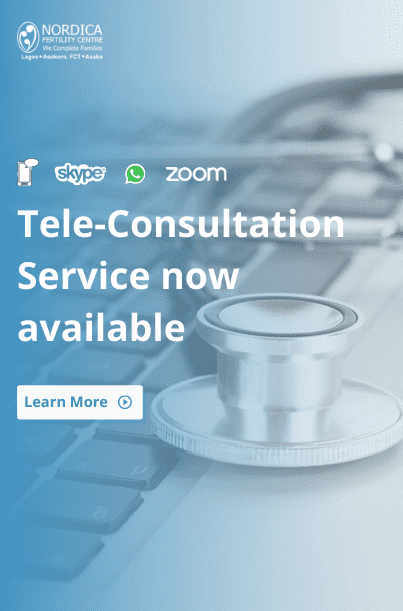Fertility Talk With Dr Abayomi Ajayi: Journey Through Infertility
Fertility Talk With Dr Abayomi Ajayi: Journey Through Infertility

Infertility Statistics
While 85% of couples are able to conceive after one year of unprotected intercourse, approximately 15% will not achieve pregnancy without some form of medical intervention. In 40% of those having difficulties with fertility, a male factor appears to be singularly responsible and in other additional 20%, both a male and female factors can be identified. This essentially means that a male factor (usually poor sperm quality) is at least partly responsible in 60% of infertile couples.
A Journey of Ups and Downs
Beyond statistics, difficulty with a life story of infertile couples may be likened to a journey of hope, sadness, unexpected surprises, emotional tension, sometimes grief and ultimately either acceptance and joy. Whatever might be the end of this journey, one thing is certain: the couple need to maintain a positive attitude, get as much support as possible (this she’ll find when she joins a support group) and have as much information as possible about the issue at hand.
But For How Long Should A Couple Wait?
Although it has often been recommended that clinical evaluation should wait until after 12 months of unprotected intercourse, but the following groups of people are exempted from this criterion: women who are already 35 years, those with irregular menstrual cycles, those who have had previous abdominal infection (Pelvic Inflammatory Disease or Sexually Transmissible Infection requiring hospitalization) and those who have had previous abdominal surgery as well as those with endometriosis. As for men, this category of men is exempted from the 12 month rule: men who have had any previous sickness relating to the testicles, those with failure of the testicles to descend into the scrotum in their childhood or those with very small testicles or considerable variation in size of both testicles.
People (men and women) who fall within these classifications will all need to see their gynaecologist earlier than the recommended one year.
Initial Evaluation
This will involve some basic screening tests for the couple to identify the cause(s) of the problem, if indeed a problem exists. For a woman, she will need to take along results of previous tests like blood tests, ultrasound scans and hysterosalpingogram (HSG) results she had done in the last year. Besides she will need to give the medical team a detailed medical history, which will include a history of the previous illnesses, treatments and their outcomes, previous surgeries, any current medical condition like hypertension and diabetes and the drugs she has taken during the treatment of such illnesses.
The medical team will also like to know the woman’s menstrual cycle pattern (past and present) as well as her sexual routine like frequency, timing and sometimes, difficulties. It is important to emphasize that the woman’s evaluation will not be complete without a thorough physical examination and an ultrasound scan, with the latter providing the opportunity to visualize her womb and ovaries to identify possible abnormalities. Other tests that will be required are hormonal profile (blood assays, including Follicle Stimulating Hormone, Luteinizing Hormone, Progesterone, Oestrogen and Prolactin levels). A hormone profile is usually very useful for the identification of ovulatory problems while a hysterosalpingogram (HSG), at the request of the medical team, would help in identifying problems of tubal blockage. Like the woman, the man also needs to give the medical team a history of his illnesses (previous childhood illnesses and very important for mention due to complications of childhood mumps infections) which may cause low sperm counts. Previous surgeries also need to be listed. Similarly, a number of toxins and drugs like anti-hypertensive and some anti-ulcer drugs need to be mentioned as they may also contribute to low sperm counts. After the history taking session, the medical team will now examine the man and thereafter request for a semen sample for analysis.
Treatment Options
Usually, the medical team will discuss the various treatment options with the couple as soon as the results are available and a total picture of the likely problems presented. The possible treatment options, depending on individual situations, may include ovulation monitoring i.e. with Clomiphene Citrate, Intrauterine Insemination (IUI), In-vitro Fertilization, Intracytoplasmic Sperm Injection (ICSI) and Intracytoplasmic Morphologically Selected Sperm Injection (IMSI) as well as egg donation with IVF.
Counseling
An important component of infertility treatment is counseling whereby couples are provided with information/counseling to improve their understanding of the often complex procedures of Assisted Reproductive Treatment (ART) such as IVF, ICSI or IMSI. But needless to say, it is not everyone that will require IVF, ICSI or IMSI. Counseling will also help the couple in the decision making process, particularly when psychological and/or moral issues are involved. And of course, there will always be consent forms to sign prior to undertaking some of the procedures.
Risks
Everywhere in the world today, there are only a few medical interventions without some elements of risks and ART is no exemption. Clomiphene Citrate used in ovulation induction may lead to ovarian cysts while both IVF and ICSI may pose a few risks which need to be properly understood. Some IVF associated risks include cancelled treatment cycles due to poor quality eggs or hyper-stimulation (also known as OHSS), which occurs when a woman over responds to the drugs administered to stimulate the egg production. She may develop swelling of the abdomen, vomiting, enlarged ovaries and abdominal pain which may require hospitalization. Another associated risk is that multiple pregnancies like twins, triplets and even more, are more common with IVF. This may sound desirable and exciting, but then multiple pregnancies are likely to be miscarried or delivered before time (premature delivery).
Pregnancy Rates
Provided that there are no problems identified with the couple following evaluation, an assumption may be rightfully made that the couple has unexplained infertility and could still achieve pregnancy on their own without treatment in 33% of cases.
For those requiring treatment, pregnancy rates are 15% with IUI, 20% with ovulation induction and 40%-50% with IVF/ICSI/IMSI. However, couples with diagnosed problems, but prefer to wait and see, have only a 2% chance of achieving pregnancy. Unfortunately, the longer a couple remains childless, the lower their chances of achieving pregnancy. It must be emphasized again that success rates with IVF is significantly dependent on age and the cause(s) of the infertility. Certainly, the bottom line is this: whosoever needs to embark on this journey should start early. The time to start is now. This is the appointed time so take a deep breath, launch out in confidence that the time has come. You will be glad you did.





